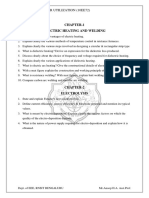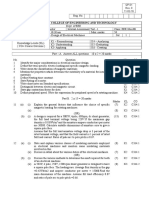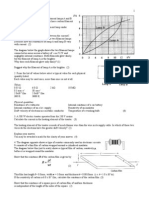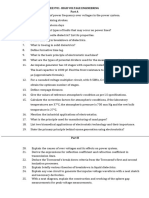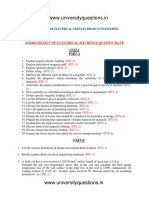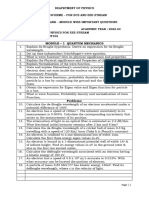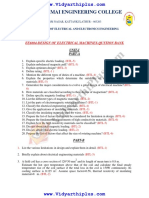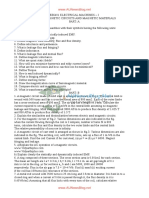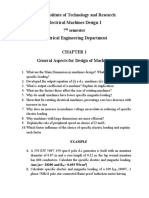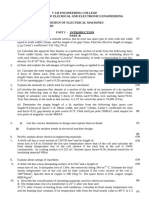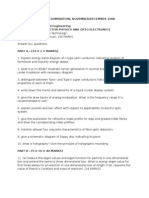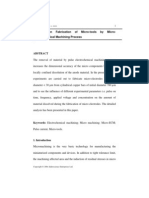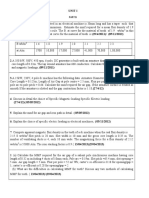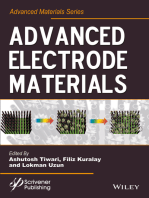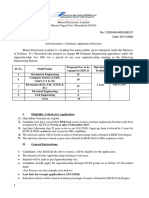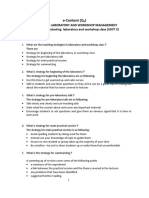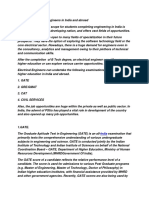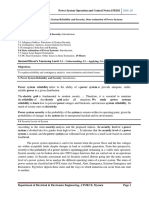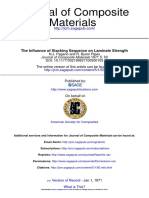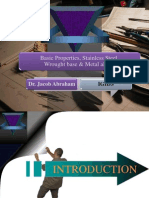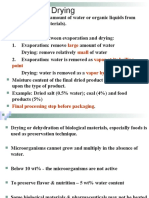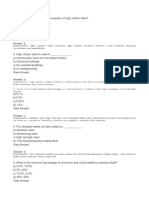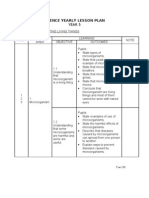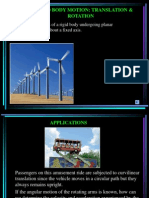Question Bank: UNIT-1 Conducting Materials
Question Bank: UNIT-1 Conducting Materials
Uploaded by
priyaCopyright:
Available Formats
Question Bank: UNIT-1 Conducting Materials
Question Bank: UNIT-1 Conducting Materials
Uploaded by
priyaOriginal Title
Copyright
Available Formats
Share this document
Did you find this document useful?
Is this content inappropriate?
Copyright:
Available Formats
Question Bank: UNIT-1 Conducting Materials
Question Bank: UNIT-1 Conducting Materials
Uploaded by
priyaCopyright:
Available Formats
10EE666 – ELECTRICAL ENGINEERING MATERIALS
QUESTION BANK
UNIT-1
CONDUCTING MATERIALS
1] Explain the different types of materials used for the manufacturing of brushes.
2] With usual notations prove that RT = Rt [1+αt(T-t)].
3] Explain effect of temperature on resistance and hence derive an expression for temperature
coefficient of resistance.
4] The resistance of wire increases 40 ohms at 28 0C to 50 ohms at 800C. Find the temperature
coefficient of the material at 00C.
5] A field coil 150C takes 5A when a voltage of 250V is applied. Find the mean temperature
of coil if the current reduces to 4A for same impressed voltage. The coil is made of copper.
Resistance coefficient of copper at 00C is 0.0038.
6] Explain the factors affecting the electrical conductivity of metals.
7] List the postulates of classical free electron theory for metallic conduction.
8] Calculate the current produced in small germanium plate of area 1cm 2 and of thickness
0.3mm when a potential difference of 2V is applied across the faces. Concentration of free
electron in germanium is 2 x 1019 per m3 and mobility of electron and holes are 0.36 m2 /v-s
and 0.17 m2 /v-s respectively. Take e=1.6x10-19 coulomb.
9] The resistivity of a pure copper is 1.56 micro-ohm-cm. An alloy of copper containing 1
atomic percent nickel has a resistivity of 2.81 micro-ohm-cm. An alloy of copper containing
3 atomic percent silver has a resistivity of 1.98 micro-ohm-cm. What is the resistivity of an
alloy containing 2 atomic percent nickel and 2 atomic percent silver?
10] A copper wire and aluminium wire have same length and resistance. If same current
passes through both the wires, which wire will attain higher temperature rise? Give reason.
11] Explain Fermi dirac distribution
12] Explain briefly the uses of the following in electrical industry :
a)Silver b)Aluminium c)Copper d)Tungsten
13] Explain the different materials that can be used for lamp filaments.
14] The resistances of armature winding of a motor at 00 C is 80Ω. Find the resistances at
400C, if the temperature coefficient of copper is 0.0043
UNIT-2
SEMICONDUCTORS AND MAGNETIC MATERIALS
1] Bring out the difference between hard and soft magnetic materials.
DEPT OF EEE, PACE PAGE 1
10EE666 – ELECTRICAL ENGINEERING MATERIALS
2] The total loss in a sample of sheet weighing 10kg is 20watts at 50 c/s and 35watts in 75c/s,
both being, measured at same peak flux density. Separate the loss at 50c/s into its hysteresis
and eddy current components.
3] An electrical field of 80v/m is applied to sample of n type semiconductor whose hall
coefficient is 0.0125m3 /c. Determine the current density in the sample µc =0.36m2 v-1 s-1.
4] Write a short note on intrinsic and extrinsic semiconductors.
5] Name five factors affecting semiconductors.
6] Name any five devices that use semiconductors.
7] Briefly explain Hall Effect generators.
8] Obtain the expression for conductivity of an intrinsic semiconductor.
9] A rectangular n-type germanium bar has a thickness 2mm. A current of 10amps passes
along the bar and field of 0.1tesla is applied perpendicular to the current flow. The hall
voltage developed 1mvolt .calculate the hall constant and electron density in the
semiconductor. Find the hall angle, assuming a mobility of 0.36m2 /v-s for the carriers.
10] Explain the classification of magnetic materials and give examples for each.
11] Explain different types of semiconductor.
12] What is the special type of steal used for the core of power transformer? Give reasons.
Can the same material be used for electric motors.
13] Define hall effect, with a necessary sketch, explain the concept of hall effect and arrive at
an equation for hall effect voltage VH.
14] Mobility of electron and holes in a sample intrinsic GC at room temperature are
3600cm2 /v-s and 1700cm2 /v-s.if electrons and holes density are each equal to 2.2x10 13 cm3.
Calculate the conductivity.
15] Draw a typical hysteresis loop for Ferro-magnetic materials and explain. Show the
residual magnetism and coercive force on a loop and define them.
16] Briefly explain the compound semiconductors.
UNIT-3
DIELECTRICS
1] Define dielectric materials. What are the types of dielectric materials? Explain the
behaviour of dielectric in alternating fields.
2] Explain ‘dielectric polarisation’ and ‘dipole moment’.
3] An air condenser of capacitance 0.005µF is connected to a dc supply of 500 V. It is then
disconnected from the supply and immersed in oil with a dielectric constant of 2.5 Find the
energy stored in the condenser before and after immersion
DEPT OF EEE, PACE PAGE 2
10EE666 – ELECTRICAL ENGINEERING MATERIALS
4] A p.d. of 15kV is applied across the terminals of a capacitor consisting of two circular
metal plates each having an area of 200cm2 and separated by 1 mm thickness of dielectric.
The capacitance of the capacitor is 4.5x10-4 µF. Calculate the dielectric constant and the
electric flux density. Assume permittivity as 8.854x10-12 F/m.
5] A parallel plate capacitor has an area of 8 cm 2, with separation of 0.08mm. The space is
filled with polystyrene. The real part of the relative dielectric constant is 2.56 and the loss
tangent is 0.7x10-4, at a frequency of 1 MHz. Calculate the capacitance and equivalent
parallel loss resistance.
6] Discuss in detail about dipolar relaxation.
7] The radius of helium atom about 0.550 A .Calculate the polarization if He and its relative
permittivity .The number of Helium atoms in volume of 1m3 is 2.7x1025 atoms?
8] What is polarization? Explain the different types of polarization.
9] A condenser is connected for 0.25 seconds across 220 V supply. The current being kept
steady at 0.22A. Calculate its charge and capacitance.
10] Calculate the capacitance of a condenser which has plates of 0.2m 2 in area separated by a
distance of 2.5x10-5 m, the dielectric having a permittivity of 5. Sketch the electric field.
11] Deduce the expression for loss tangent and brief its significance.
12] Explain the dielectric loss with expression.
UNIT-4
INSULATING MATERIALS
1] List characteristics of good insulating materials and classify them on temperature basis.
2] List out the properties of SF6 gas
3] Give the reason. Why, hydrogen gas is more coolant than nitrogen and air?
4] How is PVC resin produced? What fillers, stabilizer, plasticizes and supplementary
additives are added to strengthen its properties.
5] Explain the procedure for testing dielectric strength of transformer oil.
6] Briefly explain gaseous insulators.
7] Explain the properties and uses of any two gaseous insulating materials.
8] What is the function of oil which is used in transformer?
9] Suggest suitable materials for the following: a) Cross arms in an overhead line. b) Fuse
carriers. C) Motor brushes. D) Electric iron.
10] Classify and list the solid, liquid and gaseous insulating materials. Suggest were these
insulators are used in Electric field applications.
DEPT OF EEE, PACE PAGE 3
10EE666 – ELECTRICAL ENGINEERING MATERIALS
UNIT-5
MATERIALS FOR SPECIAL APPLICATIONS
1] With a neat sketch, explain the working of fuel cell.
2] Explain the working of a solar cell, with a neat figure and write the equivalent circuit and
V-I characteristics.
3] List the material used in battery.
4] Give the physical and chemical properties of material used for solar cell.
5] Explain selective absorber coating. What are the selective coating properties?
6] Explain the various types of solar cells and their material compositions.
7] Explain the following 1) Mirror protective over coating.
2) Vacuum reflective over coating.
8] A stand- alone photovoltaic system is used for water pumping. It uses a dc to ac inverter
and an induction motor. The delta of this system: motor rated voltage 100V (rms), efficiency
of motor pump set 40%,efficiency of inverter 85%, head of water (to be lifted) 50m,Volume
of water 25m3 per day. Assume that each PV panel module has an output voltage of 18V and
power rating of 40W and annual output of array is 2000 Wh/Wp density of water 1000 kg/m3.
The system uses a full bridge inverter. Find:
1. Peak watt capacity of PV panel
2. No. of modules in series in a string and the string in parallel
9] Explain the following:
1) Cold mirror coatings
2) Heat mirror coatings
UNIT-6
MODERN TECHNIQUES FOR MATERIALS STUDIES
1] How does magnetic resonance imaging work?
2] Write a note on ‘ferromagnetic resonance’
3] Explain pulsed fourier transform NMR spectrometer, with a block diagram.
4] Define: spin –spin coupling
5] With neat diagram explain the following component used in atomic absorption
spectrometer
1. Radiation sources
2. Atomizer
3. Monocromotor
DEPT OF EEE, PACE PAGE 4
10EE666 – ELECTRICAL ENGINEERING MATERIALS
4. Detector
5] Draw the neat sketch of electronic microscopy and explain the construction and working.
6] What is electron spin resonance (ESR)? Explain the experimental setup of ESR with
suitable graph
7] Explain the concept of Nuclear Magnetic Resonance (NMR) with the help of experimental
set up.
UNIT-7
SMART MATERIALS
1] Define ferromagnetic curie temperature
2] Explain “magnetostriction” with reference to iron, cobalt and nickel.
3] Explain the properties of any two ferromagnetic materials
4] What is piezo-electric? Explain which the material used in piezo-electric are and list the
applications of piezo-electric material.
5] Explain the magnetostrictive material.
6] Write a note on smart hydrogel.
7] What are the advantage, disadvantage and application of piezoelectric devices?
UNIT-8
CERAMICS
1] Write a short note on the following:
1) Application of ceramics.
2) Rubber manufacture.
3) Classification of glass.
4) Neoprene
2] Explain the details the classification of ceramic capacitor.
3] What are the general properties of ceramics material and how it is applicable to capacitor?
4] Distinguish between thermoplastic and thermosetting material.
5] What are the type of rubber and give the applications of each type.
6] What are plastics? Explain the properties of plastic. Its classification and hence explain
thermoplastic.
7] Explain the thermoplastic and thermosetting material and give examples for each.
DEPT OF EEE, PACE PAGE 5
10EE666 – ELECTRICAL ENGINEERING MATERIALS
8] Bring out the difference between thermoplastic and thermosetting plastic.
DEPT OF EEE, PACE PAGE 6
You might also like
- T1-T7Q Ee2005 NtuDocument10 pagesT1-T7Q Ee2005 NtuamosmarongshengNo ratings yet
- P-PPC40-510-001 05 PPC40 User's GuideDocument19 pagesP-PPC40-510-001 05 PPC40 User's GuideFisica TacuaremboNo ratings yet
- Manual, Type 80 Koomey UnitDocument52 pagesManual, Type 80 Koomey Unitstevo3009100% (9)
- Unit 3Document1 pageUnit 3priyaNo ratings yet
- Chapter-1 Electric Heating and Welding: Electrical Power Utilization (10ee72)Document2 pagesChapter-1 Electric Heating and Welding: Electrical Power Utilization (10ee72)Akshay RajNo ratings yet
- Emd QBDocument7 pagesEmd QBAditya ShrivastavNo ratings yet
- IA 1 Set 1Document1 pageIA 1 Set 1Gokul ChandrasekaranNo ratings yet
- ElectricityDocument9 pagesElectricitySri PratheepanNo ratings yet
- Electrical Machine DesignDocument5 pagesElectrical Machine DesignsharmiladevyNo ratings yet
- Edexcel A-LEVEL PHY2 June 2003 QPDocument2 pagesEdexcel A-LEVEL PHY2 June 2003 QPapi-3726022No ratings yet
- Edexcel A-LEVEL PHY2 January 2002 QPDocument2 pagesEdexcel A-LEVEL PHY2 January 2002 QPapi-3726022No ratings yet
- Electrical Machine DesignDocument9 pagesElectrical Machine DesignSandeep KumarkjNo ratings yet
- PHY2 January 2004Document2 pagesPHY2 January 2004api-3726022No ratings yet
- EE3701Document2 pagesEE3701santhosheee19973No ratings yet
- University of Moratuwa, Sri LankaDocument4 pagesUniversity of Moratuwa, Sri LankaChanna AshanNo ratings yet
- EE3012 May2012Document4 pagesEE3012 May2012Amazing ElectricalNo ratings yet
- ECE415A Endsem1Document4 pagesECE415A Endsem1V Prakash SinghNo ratings yet
- Ee 6604 Design of Electrical Machines Question BankDocument12 pagesEe 6604 Design of Electrical Machines Question BankAlex Neo XanderNo ratings yet
- Emailing Module Wise Important QuestionsDocument4 pagesEmailing Module Wise Important QuestionsmanyamdwdNo ratings yet
- Design TheoryDocument12 pagesDesign Theoryr.anushyaNo ratings yet
- EE3012 Oct2013Document4 pagesEE3012 Oct2013Amazing ElectricalNo ratings yet
- ps-II, IImidDocument5 pagesps-II, IImidGopi Pavan JonnadulaNo ratings yet
- Current Electricity AssignmentDocument8 pagesCurrent Electricity AssignmentAviram YadavNo ratings yet
- Question Bank For Physics - Ii Regulation 2013Document10 pagesQuestion Bank For Physics - Ii Regulation 2013PRIYA RAJINo ratings yet
- EE3013 Aug2018Document3 pagesEE3013 Aug2018Amazing ElectricalNo ratings yet
- Electricity Worksheet No1Document3 pagesElectricity Worksheet No1rsanjay6tha2No ratings yet
- EE6604-Design of Electrical MachinesDocument12 pagesEE6604-Design of Electrical MachinesGokul ChandrasekaranNo ratings yet
- EE6401 Electrical Machines IDocument11 pagesEE6401 Electrical Machines IU Muthu RamanNo ratings yet
- FEpapersDocument107 pagesFEpapersChetan BhagatNo ratings yet
- Physics Xii Target Paper by Sir MuneebDocument8 pagesPhysics Xii Target Paper by Sir MuneebZair HussainNo ratings yet
- DEM PART B-Problems FinalDocument22 pagesDEM PART B-Problems FinalGokul Chandrasekaran100% (1)
- Ee6401 IqDocument6 pagesEe6401 IqK.Swetha PriyadharshiniNo ratings yet
- Ee8701 - Hve Question BankDocument7 pagesEe8701 - Hve Question BankRajkumar ArunachalamNo ratings yet
- Electrical Machine Design - Department of Electrical and Electronics EngineeringDocument8 pagesElectrical Machine Design - Department of Electrical and Electronics Engineeringni60No ratings yet
- Assignment On Current ElectricityDocument3 pagesAssignment On Current ElectricitypardeeplusNo ratings yet
- Ee 1451 - Electrical Energy Generation Utilisation and Conservation Question BankDocument10 pagesEe 1451 - Electrical Energy Generation Utilisation and Conservation Question BankSanjai RamasamyNo ratings yet
- Utilization of Electrical EnergyDocument4 pagesUtilization of Electrical Energysathyasri2011No ratings yet
- Emd-I AssignmentDocument6 pagesEmd-I Assignmentayan PatelNo ratings yet
- Combined First and Second Semester B.Tech. Degree Examination, May 2009 Basic Electrical Engineering (Cmnphetarufb) (2003 Scheme)Document4 pagesCombined First and Second Semester B.Tech. Degree Examination, May 2009 Basic Electrical Engineering (Cmnphetarufb) (2003 Scheme)Emmanuel JosephNo ratings yet
- B.E. (Electrical) : (Semester - II) High Voltage Engineering (2008 Course) (Elective - III (B) )Document3 pagesB.E. (Electrical) : (Semester - II) High Voltage Engineering (2008 Course) (Elective - III (B) )vijay patilNo ratings yet
- High Voltage Engineering QuestionsDocument4 pagesHigh Voltage Engineering QuestionsIsradani MjNo ratings yet
- Resistance and Resistivity QsDocument2 pagesResistance and Resistivity Qssanjay.vullisNo ratings yet
- dem part b cDocument10 pagesdem part b cHOD EEENo ratings yet
- Worksheet Class Xii Physics Chapter 3 Current Electricity Module - 2 June Aecs Narora SH Girish KumarDocument1 pageWorksheet Class Xii Physics Chapter 3 Current Electricity Module - 2 June Aecs Narora SH Girish KumarParbhakar Kumar BharduwasNo ratings yet
- Chapter10pp090 101 PDFDocument12 pagesChapter10pp090 101 PDFInderMaheshNo ratings yet
- 9 TransformerDocument7 pages9 TransformerMThana BalanNo ratings yet
- Ee6007 Mems Question BankDocument4 pagesEe6007 Mems Question Bankbaraniinst6875No ratings yet
- Beeg1001 Assignment 1Document1 pageBeeg1001 Assignment 1Sakshat LakhianiNo ratings yet
- PH 136 - Semiconductor Physics and Opto ElectronicsDocument3 pagesPH 136 - Semiconductor Physics and Opto ElectronicssubhazNo ratings yet
- Analysis On Fabrication of Micro-Tools by Micro-Electrochemical Machining ProcessDocument33 pagesAnalysis On Fabrication of Micro-Tools by Micro-Electrochemical Machining ProcessXu WeixingNo ratings yet
- Design of Tesla's Two-Phase Inductor: Đorđe M. Lekić, Petar R. MatićDocument8 pagesDesign of Tesla's Two-Phase Inductor: Đorđe M. Lekić, Petar R. MatićJosé Antonio NevesNo ratings yet
- Electrotechnics N4 August 2022 Question Paper PDFDocument9 pagesElectrotechnics N4 August 2022 Question Paper PDFPetro Susan Barnard100% (1)
- Dem Unit I-VDocument11 pagesDem Unit I-VHari SankarNo ratings yet
- High Voltage Engg Question BankDocument7 pagesHigh Voltage Engg Question Bankriyentandel47123No ratings yet
- EE8002 DEA QB All UnitsDocument7 pagesEE8002 DEA QB All Units5062-SANJAY RNo ratings yet
- Ele 510 (Elective I) Id E0490Document2 pagesEle 510 (Elective I) Id E0490Ravi VermaNo ratings yet
- Module 3 QuestionsDocument1 pageModule 3 QuestionsDhrutvan Reddy ReddiwaryNo ratings yet
- RGPVDocument77 pagesRGPVbhagwatmeena8839829058No ratings yet
- 12 - TH 3-Mark QuestionsDocument6 pages12 - TH 3-Mark Questionssameernazeer19751975No ratings yet
- Impedance Spectroscopy: Theory, Experiment, and ApplicationsFrom EverandImpedance Spectroscopy: Theory, Experiment, and ApplicationsEvgenij BarsoukovNo ratings yet
- An Essential Guide to Electronic Material Surfaces and InterfacesFrom EverandAn Essential Guide to Electronic Material Surfaces and InterfacesNo ratings yet
- Module-5 B) Three Phase Induction Motor Construction:: (I) Stator (Ii) RotorDocument10 pagesModule-5 B) Three Phase Induction Motor Construction:: (I) Stator (Ii) Rotorpriya100% (1)
- B. E. Syllabus: Electrical & Electronics Engineering 2018-22 BatchDocument149 pagesB. E. Syllabus: Electrical & Electronics Engineering 2018-22 BatchpriyaNo ratings yet
- BRP Bee Module 5Document16 pagesBRP Bee Module 5priyaNo ratings yet
- DSP Lab ManualDocument95 pagesDSP Lab ManualpriyaNo ratings yet
- BRP Bee Module 4Document16 pagesBRP Bee Module 4priyaNo ratings yet
- BRP Bee Module 3Document17 pagesBRP Bee Module 3priyaNo ratings yet
- Research & Innovation Research Paper Publications IPR and Patents Research Projects & Fund RaisingDocument8 pagesResearch & Innovation Research Paper Publications IPR and Patents Research Projects & Fund RaisingpriyaNo ratings yet
- BRP Bee Module 1Document15 pagesBRP Bee Module 1priyaNo ratings yet
- BRP Bee Module 2Document17 pagesBRP Bee Module 2priyaNo ratings yet
- 1brochure - June-Oct, 2021Document19 pages1brochure - June-Oct, 2021priyaNo ratings yet
- Introduction To Electrical Engineering - v1Document17 pagesIntroduction To Electrical Engineering - v1priyaNo ratings yet
- B. E. Syllabus: V & Vi SemesterDocument97 pagesB. E. Syllabus: V & Vi SemesterpriyaNo ratings yet
- VII & VIII-eleDocument197 pagesVII & VIII-elepriyaNo ratings yet
- BT - II YearDocument47 pagesBT - II YearpriyaNo ratings yet
- Graduate Advt 2020 English 04 11 2020Document5 pagesGraduate Advt 2020 English 04 11 2020priyaNo ratings yet
- E-Content (Q) Programme: Laboratory and Workshop Management (Module III) Performance Assessment in Laboratory and WorkshopDocument7 pagesE-Content (Q) Programme: Laboratory and Workshop Management (Module III) Performance Assessment in Laboratory and WorkshoppriyaNo ratings yet
- Bvoc Solar Energy Semester I-Ii 2019-20Document25 pagesBvoc Solar Energy Semester I-Ii 2019-20priyaNo ratings yet
- Programme: Laboratory and Workshop Management Module II:Conducting Laboratory and Workshop Class (UNIT II)Document5 pagesProgramme: Laboratory and Workshop Management Module II:Conducting Laboratory and Workshop Class (UNIT II)priyaNo ratings yet
- ScopeDocument6 pagesScopepriyaNo ratings yet
- E-Content (Q) Programme:Laboratory and Workshop Management Module II:Planning A Laboratory or Workshop Class (Unit I)Document3 pagesE-Content (Q) Programme:Laboratory and Workshop Management Module II:Planning A Laboratory or Workshop Class (Unit I)priyaNo ratings yet
- LWM - W3RM1Document4 pagesLWM - W3RM1priyaNo ratings yet
- Electrical Engineering: ReviewDocument30 pagesElectrical Engineering: ReviewpriyaNo ratings yet
- ASSIGNMENT 2020 (Feb-Mar)Document10 pagesASSIGNMENT 2020 (Feb-Mar)priyaNo ratings yet
- LWM - W1RM1Document5 pagesLWM - W1RM1priyaNo ratings yet
- Module 5notes - PSOCDocument14 pagesModule 5notes - PSOCpriyaNo ratings yet
- Module 4Document19 pagesModule 4priyaNo ratings yet
- Heat Treating of Magnesium Alloy Metal-Matrix Composites: Chongchen Xiang and Nikhil Gupta, New York UniversityDocument10 pagesHeat Treating of Magnesium Alloy Metal-Matrix Composites: Chongchen Xiang and Nikhil Gupta, New York UniversityAmin AminiNo ratings yet
- Illumination AdditionalDocument80 pagesIllumination Additionalbutohpakang100% (1)
- Flexure Beam Analysis and Design - (Printed)Document18 pagesFlexure Beam Analysis and Design - (Printed)saleh34534rf34No ratings yet
- BDD 40903 Injection Mold Design Chapter 6Document52 pagesBDD 40903 Injection Mold Design Chapter 6Churreya Chai LomNo ratings yet
- DLL Science 7 4th WeekDocument7 pagesDLL Science 7 4th WeekMary Angelie GreciaNo ratings yet
- Stac 13Document9 pagesStac 13KINDUNo ratings yet
- SLOPEWDocument4 pagesSLOPEWBraian LlanosNo ratings yet
- Scope of Work For Third Party InspectionDocument344 pagesScope of Work For Third Party Inspection刘晖No ratings yet
- Mankenberg dm618 enDocument3 pagesMankenberg dm618 enDanielNo ratings yet
- GTE End-Sem 1Document3 pagesGTE End-Sem 1Dairy MilkNo ratings yet
- Wrought Alloys in Orthodontics ..Basic PropertiesDocument27 pagesWrought Alloys in Orthodontics ..Basic PropertiesJacob AbrahamNo ratings yet
- Electrochemical Deburring Principle and EquipmentsDocument30 pagesElectrochemical Deburring Principle and EquipmentsBARANINo ratings yet
- Purpose of Drying: Large Small Vapor at Its Boiling Point Vapor by AirDocument56 pagesPurpose of Drying: Large Small Vapor at Its Boiling Point Vapor by AirNadia Asyiqin0% (1)
- DOS - Base Plate - 2Document23 pagesDOS - Base Plate - 2Inam UllahNo ratings yet
- Saipem Spa Saipem GMAW Welding System WeDocument25 pagesSaipem Spa Saipem GMAW Welding System WeAdi SunaryoNo ratings yet
- PDF of MCQDocument26 pagesPDF of MCQSamadhan SawantNo ratings yet
- Experiment No. 2 Pressure Measuring Instruments: ObjectivesDocument3 pagesExperiment No. 2 Pressure Measuring Instruments: ObjectivesAltamash MunirNo ratings yet
- L&T Construction Heavy Civil Infrastructure - Edrc: Design of Supporting BeamDocument8 pagesL&T Construction Heavy Civil Infrastructure - Edrc: Design of Supporting BeamNikhil PhulNo ratings yet
- Report 2Document17 pagesReport 2hoanggia3107No ratings yet
- Eve Online Salvage CalculatorDocument16 pagesEve Online Salvage CalculatorAnonymous jSTkQVC27bNo ratings yet
- Simple Super MacroMicroscope Webcam ConversionDocument7 pagesSimple Super MacroMicroscope Webcam ConversionClark McCulloughNo ratings yet
- Rancangan Tahunan Sains Tahun 5Document9 pagesRancangan Tahunan Sains Tahun 5Som Mai EmaiNo ratings yet
- Fluent Theory Guide-101-136Document36 pagesFluent Theory Guide-101-136SergioCavaleriNo ratings yet
- Lecture 16Document25 pagesLecture 16Chauhdary Fazeel AhmedNo ratings yet
- Hydrogels and Its Applications: Damanhour University Faculty of PharmacyDocument7 pagesHydrogels and Its Applications: Damanhour University Faculty of Pharmacyزياد محمدNo ratings yet
- Hitec 8888Z Atf C4 & To4 - TDSDocument2 pagesHitec 8888Z Atf C4 & To4 - TDSPranit More Arabian Petroleum LimitedNo ratings yet
- Ppt-Translation & RotationDocument23 pagesPpt-Translation & RotationWang Han ZhuNo ratings yet
- A 14 A - Hygroscopicity: GEA Niro Method No. A 14 ADocument3 pagesA 14 A - Hygroscopicity: GEA Niro Method No. A 14 AjoshNo ratings yet




